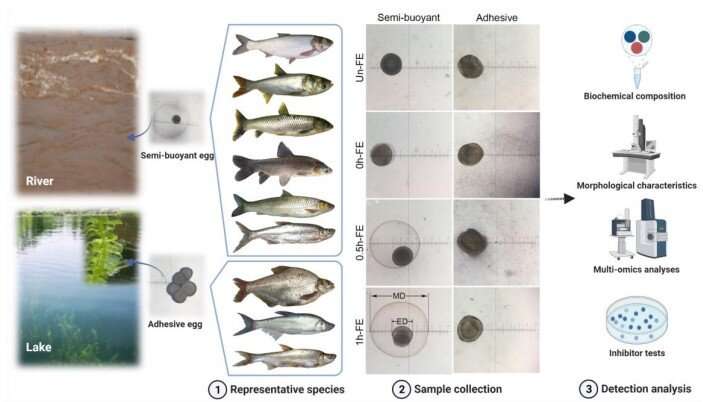A schematic of the habitats associated with semi-buoyant and adhesive eggs and the experimental design and data collection. Six representative species (H. molitrix, H. nobilis, C. idella, M. piceus, S. curriculus and C. alburnus-B) of the endemic East Asian cyprinid group that produce semi-buoyant eggs in lotic (rivers) habitats, and three representative species (M. amblycephala, C. dabryi and C. alburnus-A) of the endemic group that spawn adhesive eggs in lentic (lakes) habitats. Semi-buoyant eggs and adhesive eggs were collected unfertilized (Un-FE), and 0, 0.5 and 1 h post fertilization (0 h-FE, 0.5 h-FE, and 1 h-FE), and used for elucidating the mechanisms of hydration and adhesiveness. MD, membrane diameter; ED, egg diameter. Credit: Research (2022). https://spj.sciencemag.org/journals/research/aip/9827986/
Adaptive radiations represent rapid branching in the tree of life and are recognized as critical drivers of biodiversity. Studies on them is central to understand the mechanisms that drive speciation, diversification, and many associated ecological and evolutionary processes. During adaptive radiations, traits related to ecological and reproductive isolation play a major role in shaping biodiversity.
The endemic East Asian cyprinids, referred to as Xenocyprididae (Teleostei: Ostariophysi: Cypriniformes), are a natural assemblage of freshwater fishes rapidly evolved in eastern Asia. The evolutionary radiation of endemic East Asian cyprinids has been proposed as evolving through a change in spawning habits, involving a transition from semi-buoyant eggs to adhesive eggs in response to cross-linked river-lake system formation. However, the molecular mechanisms underpinning the marked changes in spawning habits in this adaptive radiation remain unexplored.
In a study published in Research, a research group led by Prof. Xie Ping from the Institute of Hydrobiology (IHB) of the Chinese Academy of Sciences illustrated the novel molecular mechanisms associated with hydration and adhesiveness of freshwater fish eggs, and identified critical molecular mechanisms involved in the adaptive radiation of endemic East Asian cyprinids.
The researchers compared the semi-buoyant eggs of six representative species (Cuter alburnus-B, Hypophthalmichthys molitrix, H. nobilis, Ctenopharyngodon idella, Mylopharyngodon piceus, and Squaliobarbus curriculus) with the adhesive eggs of three representative species (C. alburnus-A, Megalobrama amblycephala, and C. dabryi) belonging to the endemic East Asian cyprinid group.
They revealed critical molecular mechanisms of hydration and adhesiveness involved in the adaptive radiation of endemic East Asian cyprinids based on biochemical composition, morphological characteristics, histochemical staining, multiomics analyses, immunofluorescence and inhibitor tests.
Besides, the researchers found that semi-buoyant eggs enhance hydration by increasing the degradation of yolk protein and accumulation of Ca2+ and Mg2+ ions, while adhesive eggs improve adhesiveness and hardness of the egg envelope by producing an adhesive layer and a unique fourth layer to the egg envelope.
Multiomics analyses and verification tests showed that during the process of adaptive radiation, adhesive eggs downregulated the vitellogenin degradation pathway, zinc metalloprotease pathway and ubiquitin-proteasome pathway, and the pathways of Ca2+ and Mg2+ active transport to reduce their hydration. They showed that at the same time, adhesive eggs upregulated the crosslinks of microfilament-associated proteins and adhesive-related proteins, the hardening-related proteins of the egg envelope and the biosynthesis of glycosaminoglycan in the ovary to generate adhesiveness.
The findings of this study revealed the molecular mechanisms associated with hydration and adhesiveness in freshwater fish eggs, and elucidated the potential mechanism for the evolution of adhesive eggs from semi-buoyant eggs in the adaptive radiation of endemic East Asian cyprinids. These key egg attributes may function as "magic traits" in this adaptive radiation.
More information: Feng Chen et al, Molecular Mechanisms of Spawning Habits for the Adaptive Radiation of Endemic East Asian Cyprinid Fishes, Research (2022). spj.sciencemag.org/journals/research/aip/9827986/
Provided by Chinese Academy of Sciences
























